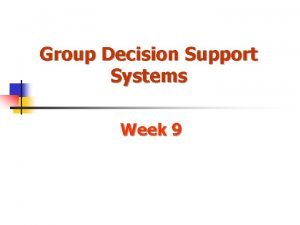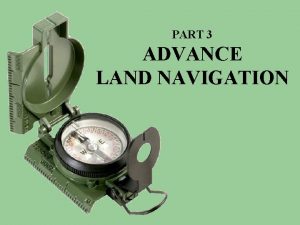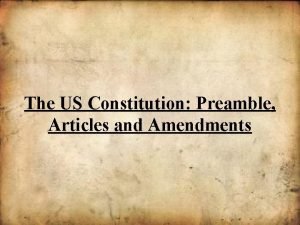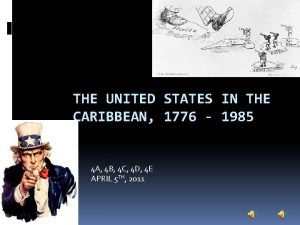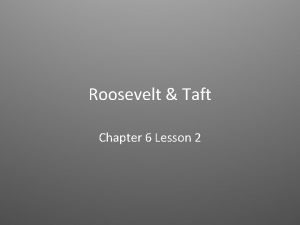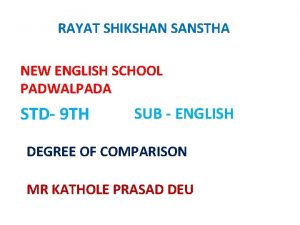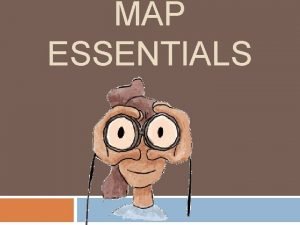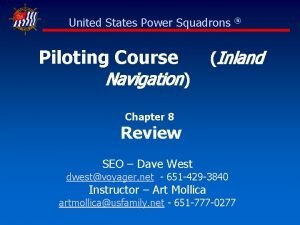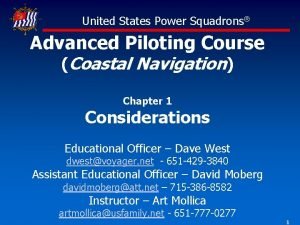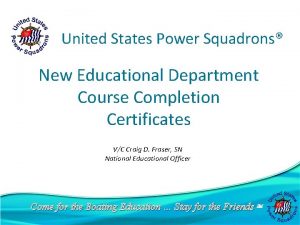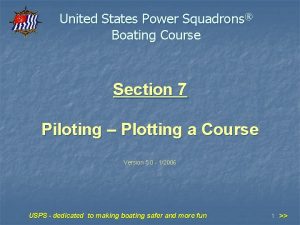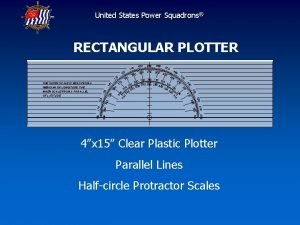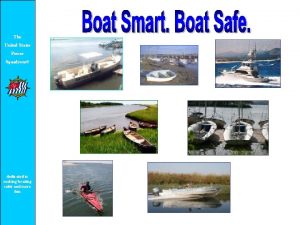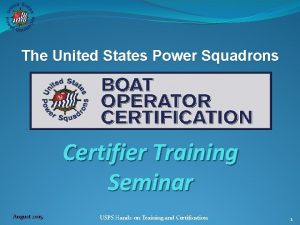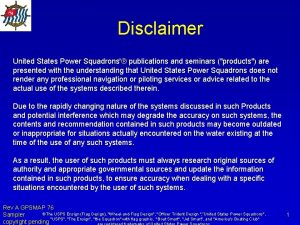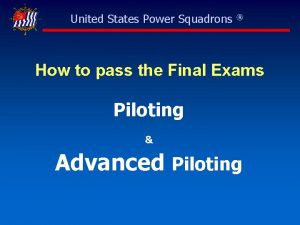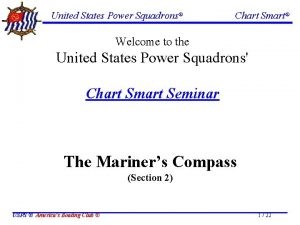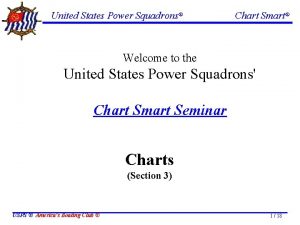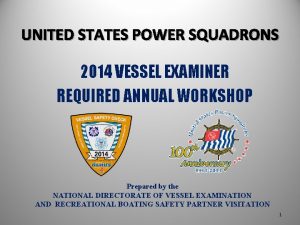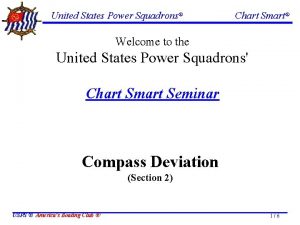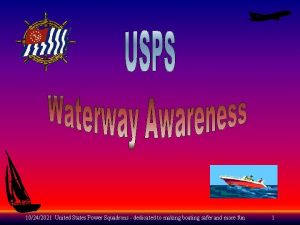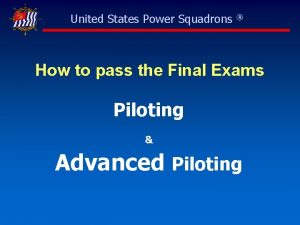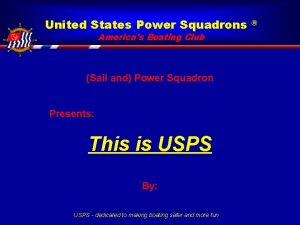United States Power Squadrons Piloting Course Navigation Inland




























- Slides: 28

United States Power Squadrons Piloting Course Navigation) ® (Inland Chapter 4 On the Water SEO – Dave West dwest@voyager. net - 651 -429 -3840 Instructor – Art Mollica artmollica@usfamily. net - 651 -777 -0277

Any questions on homework from Chapter 3? 1. In plotting a pre-planed course, use the following to represent your intended path: (d) a solid line with the course labeled. WN-Ch 5, pg 61 2. To find a DR position and plot it on a chart you must: (d) calculate the distance from a prior position. SG-Ch 3, ¶ 7 3 -8. Calculate and fill in the missing values in the table below: 3. Distance 5. 1 nm Time 38 mins Speed 8. 1 kn SG-Ch 3, ¶ 20 9. 4. 5. 46 nm 12. 6 nm 6 hr 34 min 1 hr 7 min 7. 0 kn 11. 3 kn 6. 7. 8. 10 nm 15 nm 12. 9 nm 27 min 1 hr 30 min 1 hr 45 min 22. 0 kn 10. 0 kn 7. 4 kn In order to convert a magnetic bearing to a true bearing you must apply variation based on the boat’s position. (a) True. WN-Ch 5, pg 63 -64 10. The direction of a bearing is: (c) measured from the boat to the navigational aid. Ch 5, ¶ 11. A starboard beam bearing is a relative bearing at: (c) 90º from the bow. Ch 3, fig 3 -5 b&c SGSG- 2

Any questions on homework from Chapter 3? 12. A relative bearing is measured from: (c) the bow of the boat. SG-Ch 2, pgs 36 -37 13 -15. Calculate and fill in the missing values in the table below: Magnetic Bearing Relative Bearing Magnetic Heading 13. 080º 010º 070º 14. 300º 125º 175º 15. 250º 022º 228º SG-Ch 3, ¶ 42 16. A navigation range consists of ____ navigational aids aligned to direct you along a path of water. (b) two. SG-Ch 3, ¶ 51 3

Responsibilities of the Skipper § You are responsible for the safety of • Your crew • Your boat § You decide on navigation • Use the techniques that ensure your safety § The Piloting Course provides the tools • It’s up to you to decide how to apply them 4

The Basic Technique § GPS is your primary position sensor § Ship’s Compass for Steering § Seaman’s Eye to keep in touch with surroundings § Hand-Bearing Compass to take bearings § Plot GPS Position at regular intervals (~1 hr) • Verify position via independent means 5

View from the Water § Study charts so you know what to look for § Learn to recognize ‘on-the-water’ views • Navigation Aids • Landmarks • Land Features § Practice on clear days so you know the landscape when it turns restricted 6

Use GPS as Primary Position Sensor § GPS must be properly set up • Chart Datum -- WGS 84 (or other as required) • Latitude & Longitude (grid) § Degrees, Minutes, Tenths of Minutes for most coastal charts § Degrees, Minutes, Seconds for many inland charts • Magnetic directions (preferred, auto set) • Distance and Speed – match the chart § Coastal – Nautical Miles (nm) & Knots (kn) § Great Lakes and inland lakes and rivers – Statute Miles (mi) & Miles per Hour (mph) 7

Use the Compass for Steering § GPS is NOT a compass • It provides direction based on movement history • Will not work in static situation § Compass is easier to steer with • May need to use GPS to get oriented • Then, read and follow the compass heading 8

Attributes of a Quality Compass § Repeatability • Always returns to the same reading § When returned to the same heading § or, when temporarily diverted using a magnet or metallic object § Damping $50 $200 • Turns smoothly on your boat • Sail & Powerboat compasses are different § Largest you can afford • Easier to read, smoother movement • Top reading preferred $1, 900 9

Errors Affecting Compasses Things on your boat can affect compass… § Metallic Objects • Alter local magnetic fields • Can cause compass errors § Current-carrying Wires • Create their own magnetic fields • Interfere with Earth’s field near compass § Compass Error – called DEVIATION • Dependent upon heading of boat 10

Boat Effects on Compass In another direction the metallic mass may have a much greater effect on the local magnetic field In one direction the metallic mass may have little effect on the local magnetic field 11

Dealing with Deviation § Compass can be adjusted • To counteract local deviation • Via compensating magnets in compass § Compass Adjusting • Recommend a professional adjuster § Residual Deviation • Even after compensation – some deviation • May need to correct compass readings to magnetic (or vise-versa) 12

Deviation Table § Table of Corrections Ref: WN Ch 28 – Measuring Compass Deviation using GPS 13

Correcting True to Compass subtract West add East True add West subtract East Variation M subtract West add East Magnetic M Deviation Compass add West subtract East § When converting from True to Compass • “West is Best” – add West • “East is Least” – subtract East 14

Practical Magnetic Compass Use § Typical Compass • 5° - graduated increments • Read to about 2 -3° § Properly corrected compass • Residual Deviation typically < 2° • Ignore Deviation for moderate runs 15

Fluxgate Compass § Economical Electronic Compass § Uses electronics to sense the magnetic field § Self-compensating • automatically builds deviation table • automatically applies deviation to reading • continuously updates deviation table § Extremely Accurate • Typically < 1° 16

10 MINUTE BREAK 10 9 8 7 TAKE 6 YOUR 5 4 SEATS 3 2 PLEASE 1

Plotting Magnetic § 4 x 15 Plotter uses Grid Lines • Measures True not Magnetic • Requires TVM conversion § Alternative to using Grid Lines • • Use Compass Rose Middle scale is oriented to Magnetic Measure using parallel rules Or parallel lines on 4 x 15 plotter 18

3 Scales on Compass Rose ec ae Gr M o na Tramonta Outer scale aligned with True North st ro Levante Ponente be Li co Ostro cc io Si ro Middle scale aligned with Magnetic North 19

Parallel Ruler with the Compass Rose 1. Put pencil tip or divider point on center of compass rose. 2. Mark rose scale at course. (130º) 3. Align parallel ruler with center of compass rose and course (either magnetic or true. 4. Walk parallel ruler to position. 20

Rolling Plotter w/the Compass Rose 1. Put pencil tip or divider point on center of compass rose. 2. Mark rose scale at course. (092ºM) 3. Align rolling plotter with center of compass rose and course (either magnetic or true. 4. Roll plotter to position. 110 0 12 0 23 0 0 0 14 0 32 05 209 020 0 0 15 0 21 33 0 03 15 200 0 14 0 010 000 350 340 33 21 0 20 0 03 0 0 2 20 2 03 0 04 23 0 190 010 340 05 0 0 22 160 0 24 0 000 180 360 350 170 16 190 180 0 06 0 170 070 250 31 180 260 0 0 31 270 080 13 IS READ FROM A THE OUTER SCALE UDE. THE GIT MERIDIAN OF LON PARALLEL A M FRO LE SCA INNER OF LATITUDE. 0 30 280 090 04 0 13 290 100 21

Exercise 4 -1 Plotting with rectangular course plotter and parallel ruler using the Compass Rose. Plot a course from G “ 7” Fl G 4 s Main Channel to G “ 5” Fl G 4 s GONG Main Channel. Measure and label the magnetic course using parallel rules and the nearest compass rose. M 81 0 C T = 066 V = 015 W M = 081 22

Exercise 4 -1 Plotting with rectangular course plotter and parallel ruler using the Compass Rose. Plot a course from G “ 7” Fl G 4 s Main Channel to G “ 5” Fl G 4 s GONG Main Channel. Measure and label the magnetic course using parallel rules and the nearest compass rose. C 282 M 0 12 0 010 190 0 14 32 23 05 0 0 0 340 209 020 0 0 000 180 360 350 0 03 M 81 0 C 21 15 05 0 170 16 23 190 180 0 1 0 50 200 0 000 350 34 0 1 1 0 0 31 03 40 0 21 2 30 0 32 22 03 0 0 4 0 30 0 33 0 0 0 160 06 24 0 170 250 0 180 070 31 OF LATITUDE. 280 260 13 IS THE OUTER SCALE UDE. THE GIT LON OF IAN MERID A PARALLEL INNER SCALE FROM 0 290 270 080 22 0 13 090 100 110 04 Plot a course from R “ 6” Fl R 4 s Main Channel to R “ 8” I Q R Main Channel using the rectangular course plotter and the nearest compass rose. READ FROM A T = 267 066 V = 015 W M = 282 081 23

Exercise 4 -1 Plotting with rectangular course plotter and parallel ruler using the Compass Rose. 230 08 0 07 2 20 6 0 190 0 21 0 0 0 2 2 180 2 230 02 5 0 0 010 17 0 040 03 000 0 16 050 35 0 0 34 0 0 209 000 180 20 M 280 C 2 290 300 310 0 34 33 0 320 M 0 0 15 140 130 190 16 0 17 81 0 C 180 120 C 282 M TH E ME OUTE RID RS IAN INN C ER OF ALE IS OF SC RE AL LONG LA A EF TIT RO ITUD D FR UD E. OM MA E. TH A PA E RA LL EL 010 3 270 090 1 100 210 130 140 310 320 30 50 110 220 0 Plot and label a course of 220º magnetic from R “ 4” Fl R 6 s BELL Main Channel using the rectangular course plotter and the nearest compass rose. 24 35 Plot a course from R “ 6” Fl R 4 s Main Channel to R “ 8” I Q R Main Channel using the rectangular course plotter and the nearest compass rose. 0 06 030 360 Plot a course from G “ 7” Fl G 4 s Main Channel to G “ 5” Fl G 4 s GONG Main Channel. Measure and label the magnetic course using parallel rules and the nearest compass rose. 040 050 M T == 220 267 V = 015 W T M == 205 282 24

Exercise 4 -1 Plotting with rectangular course plotter and parallel ruler using the Compass Rose. Plot and label a course of 029º magnetic from G C “ 1” Perkins Cove using parallel ruler and the nearest compass rose. M 81 0 C C 2 9 M Plot and label a course of 220º magnetic from R “ 4” Fl R 6 s BELL Main Channel using the rectangular course plotter and the nearest compass rose. C 282 M C 02 Plot a course from R “ 6” Fl R 4 s Main Channel to R “ 8” I Q R Main Channel using the rectangular course plotter and the nearest compass rose. 20 M Plot a course from G “ 7” Fl G 4 s Main Channel to G “ 5” Fl G 4 s GONG Main Channel. Measure and label the magnetic course using parallel rules and the nearest compass rose. M = 029 220 V = 015 W T = 014 205 25

Questions ? … Comments 26

Cruise and Homework § Read Chapter 5 – Student Guide § Review Chapter 5 – Weekend Navigator § Do Chapter 4 homework § Do Part I of cruise (next slide) § Next class – 21 February 27

Appendix A – Piloting Cruise 28
 Piloting procter & gamble from decision cockpits
Piloting procter & gamble from decision cockpits Piloting procter & gamble from decision cockpits
Piloting procter & gamble from decision cockpits The united states emerges as a world power
The united states emerges as a world power Degrence
Degrence Power traiangle
Power traiangle Was the united states on the axis powers or allied powers?
Was the united states on the axis powers or allied powers? Mediterranean climate in us
Mediterranean climate in us 36 30 line
36 30 line Us pro soccer organization
Us pro soccer organization Marshall case
Marshall case United states student association
United states student association The united states ought to provide a universal basic income
The united states ought to provide a universal basic income Us constitution preamble
Us constitution preamble The united states in the caribbean 1776-1985
The united states in the caribbean 1776-1985 Southeast region physical features
Southeast region physical features Expansion of the united states of america 1607 to 1853 map
Expansion of the united states of america 1607 to 1853 map Why did truman believe greece needed aid
Why did truman believe greece needed aid Previous owner of louisiana purchase
Previous owner of louisiana purchase When was awake united states written
When was awake united states written Mapp v ohio
Mapp v ohio Why did the united states invade cuba in 1898?
Why did the united states invade cuba in 1898? Lesson 2 roosevelt and taft
Lesson 2 roosevelt and taft Midwestern region of the united states
Midwestern region of the united states 7 regions of the united states
7 regions of the united states The united states is the greatest buyer positive degree
The united states is the greatest buyer positive degree United states and canada physical map
United states and canada physical map Physical features of the united states
Physical features of the united states World map with longitude and latitude lines
World map with longitude and latitude lines 50 nifty united states
50 nifty united states

